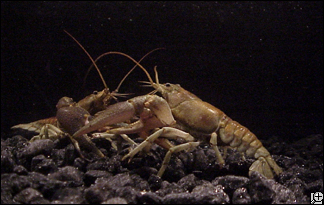

Male Crayfish Like a Good Fight
March 5, 2008

Human parents may worry about the effects of TV violence on their kids, but among male crayfish, watching a fight appears to actually chill aggression.
That finding adds to the growing body of evidence that individuals, particularly males, of many species watch competitive encounters. Viewing such events either seems to stimulate further aggression, or lessen it.
"Think about the problems some countries have during soccer matches," said Paul Moore, who co-authored the crayfish study. "Observing the competition, especially if there are a lot of fouls, tends to [intensify] the aggression in the audience."
"The concept of watching fights and having this experience change the potential outcome of the next encounter is something that matches with both studies and anecdotal evidence," added Moore, who is a professor in the Department of Biological Sciences at Bowling Green State University.
Moore and colleagues Thomas Zuland and Rebecca Zuland-Schneider chose to study crayfish because the aggressive shellfish form dominance hierarchies and engage in ritualized fighting.
During a typical fight, the crayfish approach each other with their big pinchers, chelae, out as far as possible. They then go into what is known as the "boxing phase," during which the "crayfish spend considerable amounts of time pushing and not pinching with their claws," explained Moore.
If nobody backs down, the fight escalates as the crayfish use their pinchers to grab at each other. Like wrestlers, they attempt to flip over their rivals or forcibly move them around.
If both competitors are still standing at that point, the fight reaches a final, brutal stage.
"During this rarely reached phase, the crayfish attempt to cause physical harm, such as the removal of an opponent's chelae or limb," Moore said.
For the study, the researchers created a fighting arena with retractable walls. Two males were put into the arena, while a third bystander was allowed to watch over a 15-minute period. A total of 80 bystander crayfish, collected from the Portage River in Wood County, Ohio, were used in the experiment.
After watching the fight, the observer crayfish was placed in another arena with a new opponent of comparable size.
Much to the surprise of the scientists, crayfish that previously observed an encounter rarely initiated fights. They also took longer to end fights, which escalated slowly, and lost more often than crayfish who hadn't watched an earlier battle.
The findings were published in the journal Animal Behavior.
Since crayfish may urinate during fights to release chemical cues, Moore thinks the observing shellfish might have been stimulated to do the same, "wasting" their chemicals before the real fight.
"Second, it is possible that the observing crayfish, again lacking the presence of chemical cues, was disturbed enough with the conflicting sensory information that its internal motivation to fight...was reduced," he said.
While Moore's work did not test how the observer would perform if he encountered one of the males he just watched fight, another recent study, on the Australian yabby crayfish, found that males seem to never forget the faces of foes. They prefer to fight with opponents they've encountered before, probably because they know more about them.
David MacMillan, who led the Australian research and is head of the Department of Zoology at the University of Melbourne, concluded that crayfish are "capable of more than we expected for an animal with such a simple nervous system."